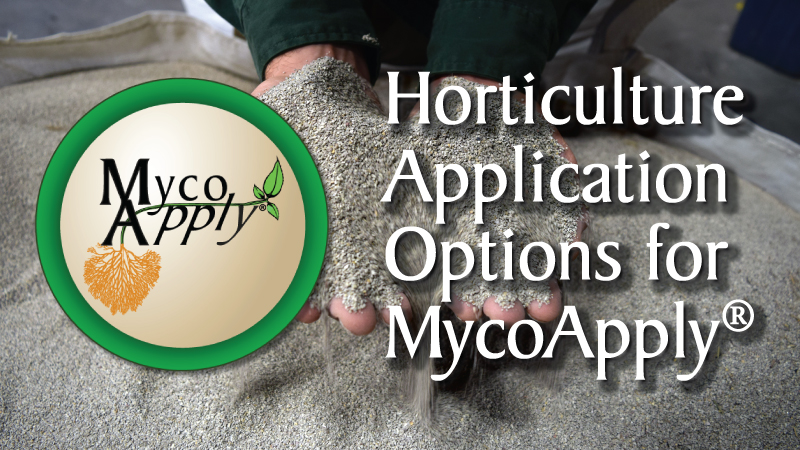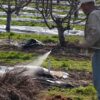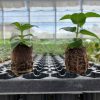
This original article was a popular read in 2019 in our Meister Sponsored Newsletter and on our Mycorrhizal Applications website. Since our MycoApply product line has progressed since its original publication in March of 2019, I thought I would update it to include some of the newest information on MycoApply application methods:
After several thousand grower visits in my career, one critical piece of information I have learned is all greenhouses and nurseries are different. For that reason, we have developed a variety of options for growers to use when applying MycoApply® mycorrhizae to their plants. The goal is to minimize changes in your current production protocol, and introduce mycorrhizae to your protocol with the maximum efficiency and lowest cost. This article focuses on applying MycoApply at the earliest stages a grower would have access to the plants.
Tray Dip
If you purchase in plugs or rooted cutting this is a perfect option for you. You start by thoroughly mixing up 2 oz. of either MycoApply® Ultrafine Endo or MycoApply® Ultrafine Endo/Ecto per 5 gallons (3.12 grams per liter) of water in a Sterilite® or similar type of tub that is large enough to submerge the entire plug tray root system into the suspension. Similar to other greenhouse processes, we suggest you use disposable gloves when you dip your trays. The plants should stay in the suspension for at least 10-15 seconds (long enough to allow the suspension to totally be absorbed by the soil plug). Allow excess solution to drain from the tray, then you can begin planting immediately. Likewise, a grower can treat the plants when they are received and hold them in the tray until the grower is ready to plant the treated plants. The tray dip of MycoApply® mycorrhizae can be combined with other products to reduce labor. Just remember, the mycorrhizae need to be applied to the plant roots, not the shoots. It will not hurt the shoots, but it could stain them.
Bareroot Spray/Dip
If you purchase bareroot perennials, roses, small fruit plants or trees this is a perfect option for you. You start by thoroughly mixing up 2 oz. of either MycoApply® Ultrafine Endo or MycoApply® Ultrafine Endo/Ecto per 5 gallons (3.12 grams per liter) of water in a 5-gallon (almost 19 liter) bucket that is large enough to submerge the entire root system of the plant into the suspension. What is different about these types of plants is we suggest adding a spreader sticker to the suspension. Certain types of spreader stickers are better with this type of process and plant material. We suggest you read the labels of what you have available and make your choice. Similar to other greenhouse/nursery processes, we suggest you use disposable gloves when you dip you’re your plants. The plants should stay in the suspension for at least 10-15 seconds (long enough to allow the suspension to totally be absorbed by the plant root system tissue). The plants can then be planted immediately. We do not suggest allowing plants to remain unplanted after treatment. Another option is to spray the bareroot plants roots with a hand or backpack sprayer. You will likewise want to plant them immediately.
Drench
This is the application option that most growers embrace. MycoApply® Injector Endo is the perfect product for this application option. Twenty grams of product will give you 100 gallons of drench using a 1:100 injector ratio. The humic carrier will dissolve completely, but the mycorrhizae itself will not, it will form a suspension. You will need some type of occasional agitation to keep the mycorrhizae in suspension if you are applying it or a longer period of time. We recommend you remove the bottom screen of your injector, so the mycorrhizae are not hindered (50 mesh) in their process of moving from concentrate to drench solution. Injector Endo can also be applied via a boom sprayer. More information on that topic is on our website.
For smaller operations, MycoApply® Ultrafine Endo or MycoApply® Ultrafine Endo/Ecto can be applied through a treatment injector. A grower needs to not scale up above the 100 gallons of drench. Both the clay that is used as a carrier and the mycorrhizae itself do not dissolve; they form a suspension when continuous agitation is applied. We suggest you mix up your suspension, then use some type of physical agitation to ensure the product stays in suspension. The mycorrhizae will come off the clay carrier. It is best to try to get most of the clay through the drench system to ensure the appropriate rate is applied. We recommend you remove the bottom screen of your injector, so the mycorrhizae and the clay are not hindered (50 mesh) in their process of moving from concentrate to drench solution.
Our dip, drench, boom sprayer and injector recommendations are our website.
Soil Incorporation
For larger scale growers, soil incorporation is often the best choice for MycoApply® use, due to ease and the reduced labor. If you are making your own soil, all you need to do is dedicate a hopper for the MycoApply® mycorrhizae. For those growers that buy a premix, if you batch mix your soil, or you have a hopper in your reconstitution/flat filling line, you can also choose soil incorporation. I find most growers that buy a premix soil do not have a hopper and then drench becomes their preferred choice of MycoApply® application. If you have the ability to incorporate, you have two particulate options, granular (similar in consistency to kitty litter) or a powder (similar in consistency to lime). Your choice between the two options should focus on three topics. First, consider how confident are you that your mix line will make a homogeneous product? If you are confident in your mix line either format will work for you. If not, I suggest the granular since you put more product per yard of soil, so it is easier to get higher homogeneity. Secondly, consider what container size will you be filling with the soil you add the MycoApply® to? If the cells are smaller than a 128 tray, my first choice would be to use the powder if you can. Third, the dosing ability of the hopper. The powders are more concentrated, so you need a more precise hopper to add the MycoApply®.
I also have growers who want to hand mix in mycorrhizae into their premix soil. For a 2.8 cf. bag you need to add 0.10 lbs. per bag of the MycoApply® granular products. For a 3.8 cf. bale that roughly is reconstituted into 7 cf. of soil you need to add 0.25 lbs. of MycoApply® Endo or MycoApply® Endo/Ecto.
Rates for all our products are included in our Soil Incorporation Recommendations, which are located on our website.
No matter which application method you choose, here are a few very important facts to understand:
- Mycorrhizae needs to be applied to the soil. It is not a foliar application. Mycorrhizae should be applied to where the plants roots are actively growing.
- There is no danger in overapplying mycorrhizae. If you underapply you just delay seeing a significant difference.
- Most greenhouse plants are Endomycorrhizal. Conifers and most hardwood trees are Ectomycorrhizal. Ericaceous plants (Azalea, Rhododendron, Blueberry) have their own type of mycorrhizae that is not commercially available. About 5% of plants (Brassica, Mustards, etc.) are non-mycorrhizal. More information is available on our website.
- You can apply MycoApply® to a container that has an unrooted cutting or an un-germinated seed, it will stay in the soil and remain dormant until the roots come in contact with the mycorrhizal propagule. Contact with growing roots and their exudates will germinate the mycorrhizal propagules and initiate the symbiosis between the plant and the mycorrhizae.
- If you apply the wrong type of mycorrhizae to a plant, it will not hurt the plant. It will only not provide substantial benefits to the plant.
- Most fungicides are fine with mycorrhizae. A fungicide interaction list is listed on our website.
- Lastly, it generally takes 4 weeks before a plant starts to benefit form a mycorrhizal relationship. And another 4 weeks before you as a grower will start to see benefits. These last four weeks will be more noticeable when the soil volume is larger.
If you have any questions about anything covered in this article, please contact us at 866-476-7800 or email us at inquiries@mycorrhizae.com.
Article by: Blair Busenbark
Mycorrhizal Applications – Sales & Commercial Marketing Manager
March 6, 2020






